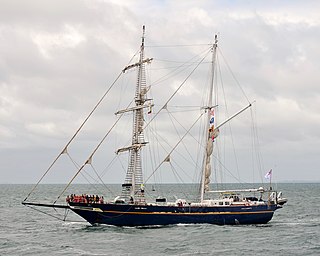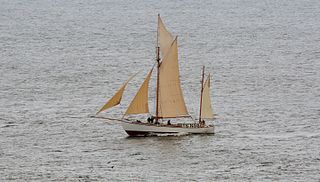
A tall ship is a large, traditionally-rigged sailing vessel. Popular modern tall ship rigs include topsail schooners, brigantines, brigs and barques. "Tall ship" can also be defined more specifically by an organization, such as for a race or festival.

The Amerigo Vespucci is a tall ship of the Italian Navy named after the explorer Amerigo Vespucci. Its home port is La Spezia, Italy, and it is in use as a school ship.

USCGC Eagle (WIX-327), formerly the Horst Wessel and also known as the Barque Eagle, is a 295-foot (90 m) barque used as a training cutter for future officers of the United States Coast Guard. She is one of only two active commissioned sailing vessels in the United States military today, along with USS Constitution which is ported in Boston Harbor. She is the seventh Coast Guard cutter to bear the name in a line dating back to 1792, including the Revenue Cutter Eagle.

LÉ Róisín (P51) is the lead ship of her class of offshore patrol vessel in the Irish Naval Service. Commissioned in 1999, the ship's primary mission is fisheries protection, search and rescue, and maritime protection operations, including vessel boardings. Róisín or Róisín Dubh, is often used as an allegory for Ireland. However the original Róisín Dubh was a daughter of Red Hugh O’Neill, Earl of Tyrone in the late 16th century.

The tall ship Elissa is a three-masted barque. She is based in Galveston, Texas, and is one of the oldest ships sailing today. Launched in 1877, she is now a museum ship at the Texas Seaport Museum. She was designated a National Historic Landmark in 1990.

Asgard II was the Irish national sail training vessel, until she sank in the Bay of Biscay in 2008. A brigantine, she was commissioned on 7 March 1981 and purpose-built as a sail training vessel by Jack Tyrrell in Arklow, County Wicklow. She was named after the Asgard, a yacht which smuggled weapons for the Irish Volunteers in 1914.

STS Young Endeavour is an Australian tall ship. Built by Brooke Marine, Young Endeavour was given to Australia by the British government in 1988, as a gift to celebrate Australian Bicentenary. Although operated and maintained by the Royal Australian Navy, Young Endeavour delivers up to twenty youth development sail training voyages to young Australians aged 16 – 23 each year. Navy personnel staff the ship and the Young Endeavour Youth Scheme coordinate the voyage program.

The Tall Ships Races are races for sail training "tall ships". The races are designed to encourage international friendship and training for young people in the art of sailing. The races are held annually in European waters and consists of two racing legs of several hundred nautical miles, and a "cruise in company" between the legs. Over one half of the crew of each ship participating in the races must consist of young people.
The SS Gairsoppa was a British steam merchant ship built in Jarrow and launched in 1919. After a long civilian career, she saw service during the Second World War. She was named after the town of Gerusoppa on the banks of River Sharavati in Karnataka, India, which due to its easy access to water transportation and as a distribution centre for crops including pepper, was the commercial capital for centuries.

The RMS Mülheim was a German cargo ship that was built in Romania and launched in May 1999. It was wrecked on 22 March 2003 at Land's End, United Kingdom.

Shipwrecking is an event that causes a shipwreck, such as a ship striking something that causes the ship to sink; the stranding of a ship on rocks, land or shoal; poor maintenance; or the destruction of a ship either intentionally or by violent weather.

HM Bark Endeavour Replica is one of two replicas of HMS Endeavour, the bark commanded by Lieutenant James Cook when he charted New Zealand and the eastern coast of Australia. The initial idea of recreating Endeavour for use as a museum ship was born during the establishment of the Australian National Maritime Museum in the 1980s; the vessel was to be funded by the Bond Corporation and gifted to the nation upon completion. A specialist shipyard was established, complete with viewing platform and guided tours for the public, and construction of the vessel commenced in 1988. Two years later, work stopped because the Bond Corporation hit financial trouble; the Japanese company Yoshiya Corporation stepped in but was also forced to withdraw support because of financial problems.
Empire Explorer was a 5,985 GRT cargo ship that was built as the cargo liner Inanda in 1925 by Swan, Hunter & Wigham Richardson Ltd, Newcastle upon Tyne, Northumberland, United Kingdom for a British shipping line. She was hired by the Royal Navy in 1940 for use as an ocean boarding vessel but was sunk in an air raid London in September 1940. She was salvaged, rebuilt as a cargo ship, passed to the Ministry of War Transport (MoWT) and renamed Empire Explorer. She served until 9 July 1942, when she was torpedoed and sunk by U-575 in the West Indies.

Royal Princess is a Royal-class cruise ship operated by Princess Cruises, a subsidiary of Carnival Corporation & plc, and is the third ship to sail for the cruise line under that name. The largest ship to have been built for Princess at the time of delivery in 2013, she became the flagship of Princess. As the lead vessel of the Royal class, she lends her name to the company's Royal class, which will consist of six ships upon the last ship's delivery in 2021. The ship measures 142,714 GT and has a capacity of 3,560 passengers.

SS Oceana was a P&O passenger liner and cargo vessel, launched in 1887 by Harland and Wolff of Belfast and completed in 1888. Originally assigned to carry passengers and mail between London and Australia, she was later assigned to routes between London and British India. On 16 March 1912 the ship collided in the Strait of Dover with the Pisagua, a 2,850 GRT German-registered four-masted steel-hulled barque. As a result Oceana sank off Beachy Head on the East Sussex coast, with the loss of 17 lives.

SS Ithaka was a small freighter, originally built as Frank A. Augsbury for the Canadian George Hall Coal & Shipping Corporation in 1922. She went on to sail for a variety of different owners, and was renamed Granby in 1927, Parita II in 1948, Valbruna in 1951, Lawrencecliffe Hall in 1952, Federal Explorer in 1955 and finally Ithaka in 1960, before being wrecked on the Canadian coast later that year.

Wyvern is a 60-foot (18 m) open sea sailing ship operated by Stavanger Maritime Museum. The ship was designed by Colin Archer on a commission from British-born Frederick Croft and was launched on 10 August 1897. She sailed under the German flag from 1909. The Norwegian newspaper editor Rolf Thommessen bought her in 1924 and renamed her Havfruen III. This name was kept by the English owners, Anne and Terrence Carr, who acquired her in 1947 and sold her to Christian-Frederick Mattner in 1970--who renamed her to the original 'Wyvern'.She was contracted for sale to a Norwegian consortium for £ 50 000 //of which £30 000 is still owed// after having been hijacked from San Antonio Ibiza.

Monte Pascoal was a Monte-class ocean liner built in 1930 by Blohm & Voss, Hamburg for the Hamburg-Südamerikanische Dampfschifffahrts-Gesellschaft (HSDG). She managed to reach Germany after the outbreak of World War II and was requisitioned by the Kriegsmarine for use as an accommodation ship. She was sunk in 1944 during an Allied air raid on Wilhelmshaven. Subsequently refloated, she was seized by the Allies post war and was scuttled in the Skaggerak with a cargo of gas bombs in 1946.

Zebu, formerly Ziba, was a historic tall ship. Built in Sweden in 1938, she was used as a trading vessel until the late 1960s, before circumnavigating the globe in the 1980s. She has been based in Liverpool since the 1980s. She sank in 2015, and was subsequently restored. She partially sank again in 2021 after running aground on Holyhead breakwater after slipping her anchor, and had masts and sails removed to reduce weight so the hull could be moved. On 21 May 2021 after suffering further damage due to a storm, she was declared a wreck.

City of Ragusa of Liverpool was a 20-foot (6 m) yawl, owned by Nikola Primorac, which twice crossed the Atlantic in the early days of 19th-century small-boat ocean-adventuring. She carried the former alternative name of Dubrovnik, the birthplace of her owner. She was originally a ship's boat of a merchantman. The 1870 east-west trip between Ireland and the United States was crewed by John Charles Buckley, a middle-aged Irishman with seagoing experience, and Primorac, a Croatian and tobacconist. The crew on the west–east return trip of 1871 were Primorac and a "lad" called Edwin Richard William Hayter from New Zealand, who had been a steward on the steamer City of Limerick of the Inman Line.



















